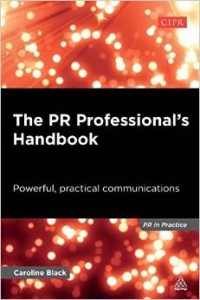How to be a consultant
About the author
Our guest authors are what make PR Place such a vibrant hub of information, exploration and learning.

I suspect only a minority of those in public relations see themselves as consultants. Either because they work in-house or because they describe their employer as an agency, not as a consultancy.
What is a consultant? The public relations literature is limited (I can only think of the excellent chapter in Anne Gregory and Paul Willis’s 2013 book Strategic Public Relations Leadership). So let’s turn to another source.
Samir Parikh, a management consultant and author of this new book, describes consulting as
‘a helping relationship based upon expertise and experience’.
Surely this includes PR practitioners (who should claim skills in relationship management) whether working in house or for an agency/consultancy.
So how do we gain the expertise and experience, and how do we gain confidence in advising clients and colleagues?
PR Professional’s Handbook: Caroline Black, an experienced PR practitioner and trainer, has written an introductory-level book. She skates across how public relations is used, covers some key PR theories and tells how to get started in the business before addressing some key skills.
It’s very broad and won’t add to the knowledge gained from a PR degree or CIPR qualification. But since the majority of practitioners don’t have either, and since public relations is a desirable graduate career, the book may appeal to many entrants.
Her final chapter covers essential skills. Writing comes first, though this is arguably a craft skill rather than a consultancy skill (you could be an excellent PR writer but struggle to be a successful PR consultant as many former journalists have found).
Then she turns to interpersonal skills and briefing skills. ‘The ability to ask great questions is, in my opinion, one of the most crucial skills anyone working in communications should master.’ She offers some useful rules and techniques for assertiveness and there’s a section on presentation skills.
The biggest surprise is hidden away in appendix two: it’s a global survey of cross-cultural communications advising on body language and etiquette. From this we learn which countries welcome direct communication (US) and which nations are the most tactile (Italy).
This book is probably most useful in helping candidates get their first PR job and survive their first two years (without eating with your left hand in the Arab world).
To learn how to advance our careers as consultants, I’ve turned to a new book from a management consultant.
The Consultant’s Handbook Samir Parikh describes how management consultancy differs from a regulated profession: you need to pass exams to call yourself a chartered accountant. ‘In consulting there are generally no such regulations’. As a consequence, ‘for clients there is a risk associated with engaging a consulting firm for the first time.’
Regulated professions (like medicine) make it hard to get in – but easy to succeed once you’ve made it. Unregulated professions (like management consultancy and public relations) are relatively easy to get into, but relatively hard to succeed in.
To give themselves the best chance to succeed, consultancies are described here as ‘knowledge management companies’.
Parikh then extends his own definition of consultancy to include the issue of ethics and conflict of interest.
‘The role of a consultant is to help a client by leveraging his or her own expertise and experience together with the collective expertise, experience and assets of his or her organization, acting in the client’s best interest as a trusted adviser.’
This leads to a distinction between consulting and selling: the first is in the interest of the client, the second in the interest of the consultancy. So consultancies succeed by offering services that meet clients’ needs (a partnership arrangement).
The book describes preparing to consult (by researching the client), establishing credibility (through positioning), managing client meetings (by setting objectives), developing proposals and delivering a consulting service.
Parikh suggests that 50% of client satisfaction will be delivered through results. The remaining 50% ‘is generated by the way in which the service was delivered and the resultant client experience.’
There’s a section on dealing with clients and a chapter on the skill of advising (‘good advice supported by clear argumentation will win the support of clients and colleagues alike’).
It’s a clearly-presented book that’s clearly applicable to public relations consultants too. There’s a missing chapter that could be supplied by PR consultants: on how to win new business. This missing chapter would cover thought leadership.
I’d recommend Caroline Black’s book to aspiring PR practitioners and I’m placing Samir Parikh’s on my bookshelf alongside the classic texts on consulting by David Maister.
The Consultant’s Handbook: A practical guide to delivering high-value and differentiated services in a competitive marketplace
By Samir Parikh
Wiley, 2015, 220 pages